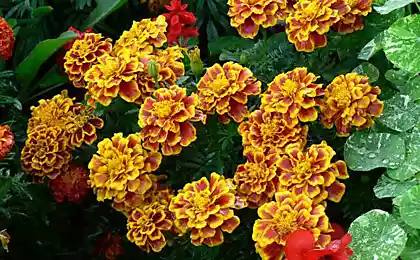1017
Nepentis
In this post we will focus on grass predator - nepentise. It is a harmless plant loves to eat all sorts of ants and grasshoppers, as well melkh rodents and even birds!
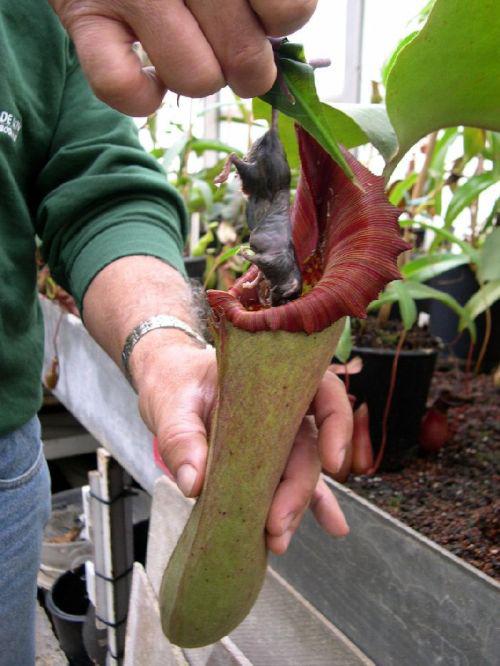
The genus Nepenthes (Nepenthes L.) includes over 70 species of plants of the family pitcher plants that grow mainly in tropical Asia; 20 - on the islands of Borneo and Sumatra; several species on the Indochina Peninsula, the Philippines, New Guinea, in tropical Australia.
Most of them - the vines, up to several meters, but there are some low bushes. Bushy vines, as a rule, are epiphytic way of life in warm and humid jungle archipelagos of the Pacific and Indian Oceans.
Most Nepenthes is vines, which reach a length of several meters, although there are low bushes. Liana bushy form, as a rule, are epiphytic way of life brought forth mainly in warm and humid jungle archipelagos of the Pacific and Indian Oceans. Nepenthes can grow and in the mountains - at an altitude of 2000 m and at the edge of the forest, and even in the area of the sea. Lianovidnye Nepenthes often settles on tree trunks obvivaya them to tens of meters in height, thereby bringing its narrow inflorescence to light.
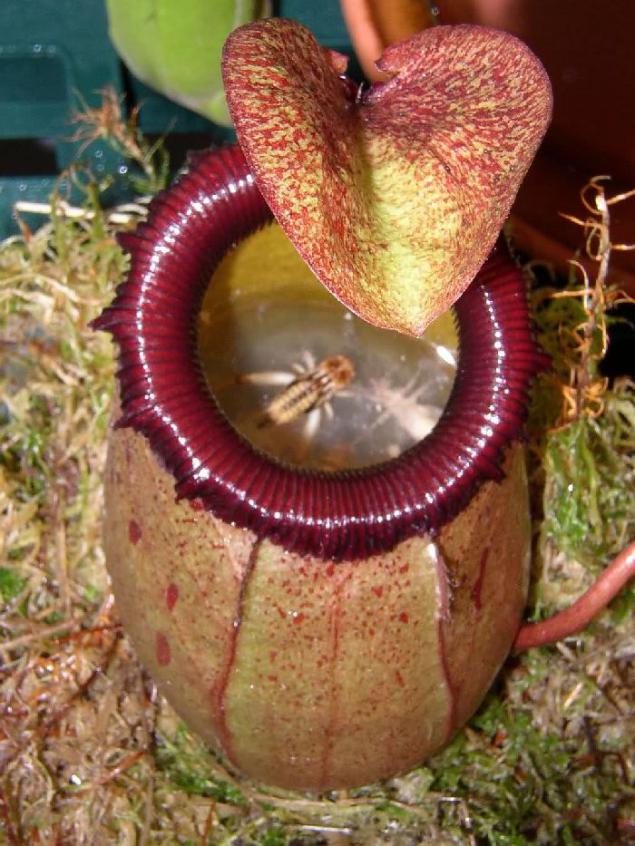
In tropical Asia, the Seychelles, Madagascar and Northern Australia inhabit the most powerful of all the "predators" - representatives of the genus Nepenthes (Nepenthes). They can grow in the mountains - at an altitude of 2000 m and at the edge of the forest, and even in the area of the sea. This vine often settles on tree trunks obvivaya them to tens of meters in height and introducing narrow inflorescence to light.
The leaves are alternate, lanceolate. Besides the usual developed urceolate leaves, where rain water accumulates. They tip extends into a long, thin mustache, which wraps around a tree branch host and ends pitcher with a lid. At the bottom - a wide plate supporting photosynthesis. The middle part is endowed with sensitivity, enabling the plant to twist the leaves of the trees. Finally, apical - jar with lid - for catching insects. On the outside of the jug downwards tested two toothed wings which serve as a support for a jug, and to guide the crawling insects.
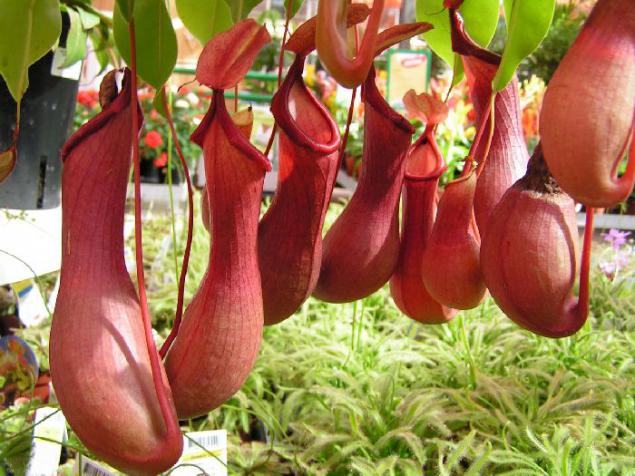
On the inner edge of jug arranged cells that produce the sweet nectar. Under them - a lot of hard hairs facing downwards - bristly stockade without giving the victim out of the jug. Wax is secreted by cells of the smooth surface of the leaves of most Nepenthes makes this surface so slippery that the victim can not help, no claws, hooks or suckers. Once in a jar trap, the insect is doomed, it sinks deeper into the water - and drown. Inside the pitcher stands proteolytic (digestive) enzyme nepentesin.

Above the mouth of the jug is fixed cap that protects the contents of the jug of rainwater and serving landing area for insects. Insects crawled inside jug, slide on its walls and are at the bottom, where they are exposed to the enzyme. Once in the liquid containing the enzymes and acids, for 5-8 hours extraction completely digested. It only remains to chitin cover. However, Nepenthes can secrete enzymes capable of dissolving even chitin.

Sometimes they gets large prey: rodents, frogs and even birds. Jug painted in bright colors: red, milky white and colored in a spotty pattern, it reaches 15-20, and sometimes even 50 cm in length, the number of accumulating enzyme can be up to 1-2 liters.
Nepenthes - dioecious plant. Male and female flowers grow on different plants. They are small, with 4 sepals, without petals are collected in inflorescence. Flowers distinguish one sex from another is almost impossible.
On the banks of freshwater bodies, found on moist soil erect Nepenthes with creeping along the ground side shoots. Pitchers such plants hidden in the grass. They can hold up to 1 - 2 liters of liquid in which several hundreds to flagged insects and sometimes - rats and small birds.

Interestingly, Nepenthes sometimes called "hunting cups" because they contain the liquid you can drink: a top jug clean water. Of course, somewhere at the bottom are undigested solids "dinners" plants. But with a certain caution until they do not get to, and almost every pitcher contains a sip or two, or even a lot more water.
Depending on catching hybrid Nepenthes pitchers are strange shapes, a variety of colors - reddish-brown, green and red, light purple, yellow, bright red, mottled. In a culture without a greenhouse or Nepenthes florariuma, unfortunately, it can be diluted only a very short time because he needs both warmth and high humidity. Small Nepenthes can be grown in a glass tank at the bottom of which poured wet concrete block. Big Nepenthes grown in hanging pots as a basket plant (away from radiators), will feel good if the bottom is a vessel with a constantly evaporating moisture. The ideal solution for increasing humidity in the room - a humidifier. It is not necessary to purchase a plant, if you can not give him the right conditions. Nepenthes effectively looks in hanging baskets or wooden compositions of which are free to hang jugs.

Nepenthes Leaves alternate, lanceolate. Along with leaves obychnyoy forms developed urceolate leaves, where rain water accumulates. They tip extends into a long, thin mustache, which wraps around a tree branch host and completed a pitcher with a cover sheet. At the bottom of the sheet is a broad plate, which is active photosynthesis. The middle part is endowed with sensitivity that allows the plant to twist the leaves and shoots of the trees nearby.
Crowned by a sheet of apical portion having a kind of jug with a lid, which is adapted for catching insects. From top to bottom on the outside of the jug are two gear-wing, which serve on the one hand support the pitcher, and the other - sent crawling insects to the entrance to the pitcher. On the inner edge of jug located secretory cells that produce the sweet nectar, and directly below them is full of stiff hairs, facing downward, forming a bristling palisade, not allowing the victim to get out of the jug. In addition, the smooth surface of the cells leaves the majority of Nepenthes stands waxy substance makes this surface is so slippery that the victim can not help any claws or hooks or suckers.

Insect, released to a jug-trap doomed, and soon it descends deeper into the water until they drown. Inside the jug secretory cells secrete proteolytic (digestive) enzyme nepentesin. Above the mouth of the jug is fixed cap that protects the contents of the jug of rainwater, and serves a kind of a landing pad for flying insects. Insects crawled inside jug, slide on its walls and are at the bottom, where it decomposes and are subject to the action of the enzyme to digest. The liquid jug containing enzymes and acid production within 5-8 hours fully digested. It was left only remnants of thick chitinous cover.

Sometimes in the West and pitchers gets larger prey, like rodents, frogs and even small birds. Jug painted in bright colors: red, milky white and colored in a spotty pattern, it reaches 15-20, and sometimes even 50 cm in length, the number of accumulating enzyme can be up to 1-2 liters.
Nepenthes - dioecious plant. Male and female flowers grow on different plants. They are small, with 4 sepals, without petals are collected in inflorescence. Flowers distinguish one sex from another is almost impossible.
On the banks of freshwater bodies, found on moist soil erect Nepenthes with creeping along the ground side shoots. Pitchers such plants hidden in the grass. They can hold up to 1 - 2 liters of liquid in which several hundreds to flagged insects and sometimes - rats and small birds.

Interestingly, Nepenthes sometimes called "hunting cups" because they contain the liquid you can drink: a top jug clean water. Of course, somewhere at the bottom are undigested solids "dinners" plants. But with a certain caution until they do not get to, and almost every pitcher contains a sip or two, or even a lot more water.

Depending on catching hybrid Nepenthes pitchers are strange shapes, a variety of colors - reddish-brown, green and red, light purple, yellow, bright red, mottled. In a culture without a greenhouse or Nepenthes florariuma, unfortunately, it can be diluted only a very short time because he needs both warmth and high humidity. Small Nepenthes can be grown in a glass tank at the bottom of which poured wet concrete block. Big Nepenthes grown in hanging pots as a basket plant (away from radiators), will feel good if the bottom is a vessel with a constantly evaporating moisture. The ideal solution for increasing humidity in the room - a humidifier. It is not necessary to purchase a plant, if you can not give him the right conditions. Nepenthes effectively looks in hanging baskets or wooden compositions of which are free to hang jugs.
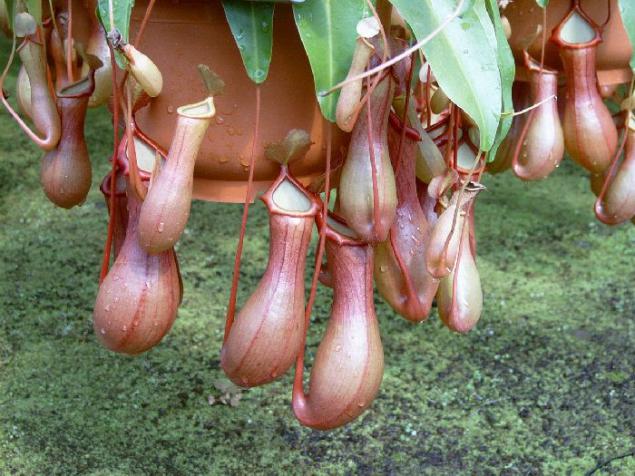
The rooms and conservatories often cultivated winged Nepenthes (N. alata). Also of interest are truncated Nepenthes (N. truncata) and Nepenthes Rafflesia (N. rafflesiana) - with large purple-spotted jugs.
Winged Nepenthes (Nepenthes alata Blanco). Motherland - the Philippines. This is one of the most common species of Nepenthes in culture.

Nepentus Madagascar (N. madagascariensis Poir.). It is widespread in Madagascar. Perennial carnivorous plant 60-90 cm tall. The leaves are oblong-lanceolate. Large jug, up to 25 cm long, winged, crimson. Cover in large glands. It is cultivated in warm and humid greenhouses.
N. Raflezi (N. rafflesiana Jack ex Hook. F.). Homeland - Kalimantan, Sumatra. Epiphyte. Leaves oval lanceolate, up to 50 cm long and 10 wide. Jar of 10-20 cm long, 7-10 cm wide, light green, red spots and stripes on long feelers in the bluish, red spots. Widely distributed in the greenhouse horticulture.

N. truncated (N. truncata Macfarl.) Is a species endemic to the island of Mindanao in the Philippines. It grows in open mountain slopes at an altitude of 230 to 600 m; a species that grow in the highlands. N. truncata has a very great pitchers that can reach up to 50 cm in length.
N. bottle (N. ampullaria Jack). A relatively small, compact form.
In Nepenthes hairy (N. villosa Hook. F.) Jugs with a diameter of 5-12 cm and 20 cm in length have a very fleshy red okolouste.
Nepenthes dvuhshporny (N. bicalcarata Hook. F.). Homeland - Borneo, growing in bogs at an altitude of 1000 m above sea level. Its leaves a length of 60 cm, and jugs - 5-13 cm in height.
Nepenthes are divided into species growing in the mountains and low-lying areas. In species native to the lowland larger and more colorful than the pitchers species growing in the mountains, and they require more care. Species growing in the mountains prefer a low temperature (not below 10 ° C), and species growing in lowland prefer not below 15 ° C.



The genus Nepenthes (Nepenthes L.) includes over 70 species of plants of the family pitcher plants that grow mainly in tropical Asia; 20 - on the islands of Borneo and Sumatra; several species on the Indochina Peninsula, the Philippines, New Guinea, in tropical Australia.
Most of them - the vines, up to several meters, but there are some low bushes. Bushy vines, as a rule, are epiphytic way of life in warm and humid jungle archipelagos of the Pacific and Indian Oceans.
Most Nepenthes is vines, which reach a length of several meters, although there are low bushes. Liana bushy form, as a rule, are epiphytic way of life brought forth mainly in warm and humid jungle archipelagos of the Pacific and Indian Oceans. Nepenthes can grow and in the mountains - at an altitude of 2000 m and at the edge of the forest, and even in the area of the sea. Lianovidnye Nepenthes often settles on tree trunks obvivaya them to tens of meters in height, thereby bringing its narrow inflorescence to light.

In tropical Asia, the Seychelles, Madagascar and Northern Australia inhabit the most powerful of all the "predators" - representatives of the genus Nepenthes (Nepenthes). They can grow in the mountains - at an altitude of 2000 m and at the edge of the forest, and even in the area of the sea. This vine often settles on tree trunks obvivaya them to tens of meters in height and introducing narrow inflorescence to light.
The leaves are alternate, lanceolate. Besides the usual developed urceolate leaves, where rain water accumulates. They tip extends into a long, thin mustache, which wraps around a tree branch host and ends pitcher with a lid. At the bottom - a wide plate supporting photosynthesis. The middle part is endowed with sensitivity, enabling the plant to twist the leaves of the trees. Finally, apical - jar with lid - for catching insects. On the outside of the jug downwards tested two toothed wings which serve as a support for a jug, and to guide the crawling insects.

On the inner edge of jug arranged cells that produce the sweet nectar. Under them - a lot of hard hairs facing downwards - bristly stockade without giving the victim out of the jug. Wax is secreted by cells of the smooth surface of the leaves of most Nepenthes makes this surface so slippery that the victim can not help, no claws, hooks or suckers. Once in a jar trap, the insect is doomed, it sinks deeper into the water - and drown. Inside the pitcher stands proteolytic (digestive) enzyme nepentesin.

Above the mouth of the jug is fixed cap that protects the contents of the jug of rainwater and serving landing area for insects. Insects crawled inside jug, slide on its walls and are at the bottom, where they are exposed to the enzyme. Once in the liquid containing the enzymes and acids, for 5-8 hours extraction completely digested. It only remains to chitin cover. However, Nepenthes can secrete enzymes capable of dissolving even chitin.

Sometimes they gets large prey: rodents, frogs and even birds. Jug painted in bright colors: red, milky white and colored in a spotty pattern, it reaches 15-20, and sometimes even 50 cm in length, the number of accumulating enzyme can be up to 1-2 liters.
Nepenthes - dioecious plant. Male and female flowers grow on different plants. They are small, with 4 sepals, without petals are collected in inflorescence. Flowers distinguish one sex from another is almost impossible.
On the banks of freshwater bodies, found on moist soil erect Nepenthes with creeping along the ground side shoots. Pitchers such plants hidden in the grass. They can hold up to 1 - 2 liters of liquid in which several hundreds to flagged insects and sometimes - rats and small birds.

Interestingly, Nepenthes sometimes called "hunting cups" because they contain the liquid you can drink: a top jug clean water. Of course, somewhere at the bottom are undigested solids "dinners" plants. But with a certain caution until they do not get to, and almost every pitcher contains a sip or two, or even a lot more water.
Depending on catching hybrid Nepenthes pitchers are strange shapes, a variety of colors - reddish-brown, green and red, light purple, yellow, bright red, mottled. In a culture without a greenhouse or Nepenthes florariuma, unfortunately, it can be diluted only a very short time because he needs both warmth and high humidity. Small Nepenthes can be grown in a glass tank at the bottom of which poured wet concrete block. Big Nepenthes grown in hanging pots as a basket plant (away from radiators), will feel good if the bottom is a vessel with a constantly evaporating moisture. The ideal solution for increasing humidity in the room - a humidifier. It is not necessary to purchase a plant, if you can not give him the right conditions. Nepenthes effectively looks in hanging baskets or wooden compositions of which are free to hang jugs.

Nepenthes Leaves alternate, lanceolate. Along with leaves obychnyoy forms developed urceolate leaves, where rain water accumulates. They tip extends into a long, thin mustache, which wraps around a tree branch host and completed a pitcher with a cover sheet. At the bottom of the sheet is a broad plate, which is active photosynthesis. The middle part is endowed with sensitivity that allows the plant to twist the leaves and shoots of the trees nearby.
Crowned by a sheet of apical portion having a kind of jug with a lid, which is adapted for catching insects. From top to bottom on the outside of the jug are two gear-wing, which serve on the one hand support the pitcher, and the other - sent crawling insects to the entrance to the pitcher. On the inner edge of jug located secretory cells that produce the sweet nectar, and directly below them is full of stiff hairs, facing downward, forming a bristling palisade, not allowing the victim to get out of the jug. In addition, the smooth surface of the cells leaves the majority of Nepenthes stands waxy substance makes this surface is so slippery that the victim can not help any claws or hooks or suckers.

Insect, released to a jug-trap doomed, and soon it descends deeper into the water until they drown. Inside the jug secretory cells secrete proteolytic (digestive) enzyme nepentesin. Above the mouth of the jug is fixed cap that protects the contents of the jug of rainwater, and serves a kind of a landing pad for flying insects. Insects crawled inside jug, slide on its walls and are at the bottom, where it decomposes and are subject to the action of the enzyme to digest. The liquid jug containing enzymes and acid production within 5-8 hours fully digested. It was left only remnants of thick chitinous cover.

Sometimes in the West and pitchers gets larger prey, like rodents, frogs and even small birds. Jug painted in bright colors: red, milky white and colored in a spotty pattern, it reaches 15-20, and sometimes even 50 cm in length, the number of accumulating enzyme can be up to 1-2 liters.
Nepenthes - dioecious plant. Male and female flowers grow on different plants. They are small, with 4 sepals, without petals are collected in inflorescence. Flowers distinguish one sex from another is almost impossible.
On the banks of freshwater bodies, found on moist soil erect Nepenthes with creeping along the ground side shoots. Pitchers such plants hidden in the grass. They can hold up to 1 - 2 liters of liquid in which several hundreds to flagged insects and sometimes - rats and small birds.

Interestingly, Nepenthes sometimes called "hunting cups" because they contain the liquid you can drink: a top jug clean water. Of course, somewhere at the bottom are undigested solids "dinners" plants. But with a certain caution until they do not get to, and almost every pitcher contains a sip or two, or even a lot more water.

Depending on catching hybrid Nepenthes pitchers are strange shapes, a variety of colors - reddish-brown, green and red, light purple, yellow, bright red, mottled. In a culture without a greenhouse or Nepenthes florariuma, unfortunately, it can be diluted only a very short time because he needs both warmth and high humidity. Small Nepenthes can be grown in a glass tank at the bottom of which poured wet concrete block. Big Nepenthes grown in hanging pots as a basket plant (away from radiators), will feel good if the bottom is a vessel with a constantly evaporating moisture. The ideal solution for increasing humidity in the room - a humidifier. It is not necessary to purchase a plant, if you can not give him the right conditions. Nepenthes effectively looks in hanging baskets or wooden compositions of which are free to hang jugs.

The rooms and conservatories often cultivated winged Nepenthes (N. alata). Also of interest are truncated Nepenthes (N. truncata) and Nepenthes Rafflesia (N. rafflesiana) - with large purple-spotted jugs.
Winged Nepenthes (Nepenthes alata Blanco). Motherland - the Philippines. This is one of the most common species of Nepenthes in culture.

Nepentus Madagascar (N. madagascariensis Poir.). It is widespread in Madagascar. Perennial carnivorous plant 60-90 cm tall. The leaves are oblong-lanceolate. Large jug, up to 25 cm long, winged, crimson. Cover in large glands. It is cultivated in warm and humid greenhouses.
N. Raflezi (N. rafflesiana Jack ex Hook. F.). Homeland - Kalimantan, Sumatra. Epiphyte. Leaves oval lanceolate, up to 50 cm long and 10 wide. Jar of 10-20 cm long, 7-10 cm wide, light green, red spots and stripes on long feelers in the bluish, red spots. Widely distributed in the greenhouse horticulture.

N. truncated (N. truncata Macfarl.) Is a species endemic to the island of Mindanao in the Philippines. It grows in open mountain slopes at an altitude of 230 to 600 m; a species that grow in the highlands. N. truncata has a very great pitchers that can reach up to 50 cm in length.
N. bottle (N. ampullaria Jack). A relatively small, compact form.
In Nepenthes hairy (N. villosa Hook. F.) Jugs with a diameter of 5-12 cm and 20 cm in length have a very fleshy red okolouste.
Nepenthes dvuhshporny (N. bicalcarata Hook. F.). Homeland - Borneo, growing in bogs at an altitude of 1000 m above sea level. Its leaves a length of 60 cm, and jugs - 5-13 cm in height.
Nepenthes are divided into species growing in the mountains and low-lying areas. In species native to the lowland larger and more colorful than the pitchers species growing in the mountains, and they require more care. Species growing in the mountains prefer a low temperature (not below 10 ° C), and species growing in lowland prefer not below 15 ° C.









